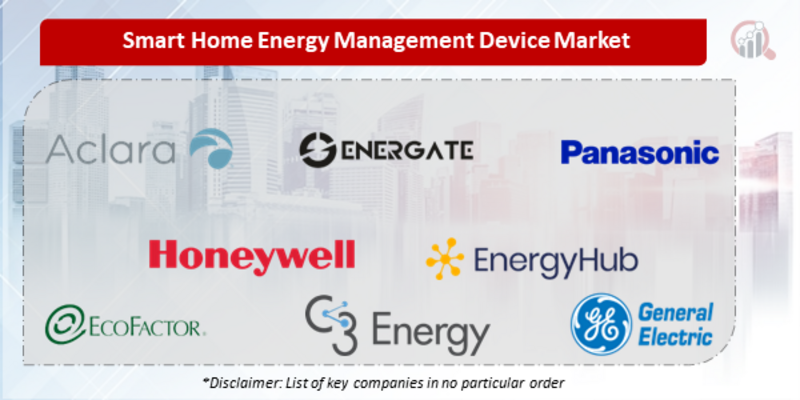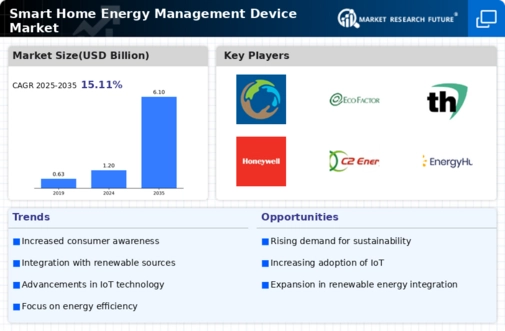Top Industry Leaders in the Smart Home Energy Management Device Market

A Competitive Landscape of Smart Home Energy Management Device Market:
The smart home energy management device (SHEMD) market is experiencing a surge in growth, fueled by rising energy costs, environmental consciousness, and technological advancements. This dynamic landscape presents both opportunities and challenges for established players and new entrants. Understanding the competitive landscape is crucial for navigating this rapidly evolving market.
Some of the Smart Home Energy Management Device companies listed below:
- Aclara
- Energate Inc.
- Panasonic Corporation
- Eco factor
- Trilliant Honeywell
- C3 Energy
- Energyhub Inc.
- General Electric Company
- Control Networks
- Nest Labs
Strategies Adopted by Key Players:
Several key strategies are shaping the competitive landscape:
- Acquisitions and Partnerships: Established players are acquiring smaller companies with innovative technologies or expanding their reach through partnerships with energy providers and smart home platform companies.
- Product Diversification: Companies are expanding their product offerings to cater to different segments and price points. This includes entry into new device categories and the development of comprehensive HEMS solutions.
- Focus on User Experience: Providing intuitive interfaces, seamless integration with existing smart home ecosystems, and data-driven insights for energy savings are becoming essential for attracting and retaining customers.
- Sustainability and Environmental Focus: Companies are emphasizing the environmental benefits of their products, aligning with the growing demand for eco-conscious solutions.
Market Share Analysis:
Analyzing market share in the SHEMD market requires a multifaceted approach. Traditional metrics like revenue and unit shipments remain important, but additional factors must be considered for a comprehensive understanding:
- Device Type: The market is segmented by device type, such as smart thermostats, smart plugs, energy monitors, and home energy management systems (HEMS). Each segment has its own growth trajectory and competitive dynamics.
- Geographic Reach: The market is growing at different rates in different regions. Factors like energy policies, consumer preferences, and infrastructure development play a significant role.
- Distribution Channels: Direct-to-consumer sales, partnerships with utility companies, and retail channels each have their own advantages and disadvantages. Understanding how companies are reaching their target markets is crucial.
- Technology and Innovation: Features like AI-powered energy optimization, integration with renewable energy sources, and seamless integration with smart home ecosystems are becoming increasingly important differentiators.
New and Emerging Players:
While established players like Ecobee, Honeywell, and Nest Labs hold significant market share, new and emerging companies are disrupting the market with innovative offerings:
- Start-ups: Agile and innovative startups are introducing new technologies, such as AI-powered demand response solutions and blockchain-based energy management platforms.
- Tech Giants: Tech giants like Amazon and Google are entering the market with their own SHEMD offerings, leveraging their existing user base and ecosystem strengths.
- Energy Providers: Utilities are increasingly offering SHEMD solutions to their customers as part of energy efficiency programs and smart grid initiatives.
Latest Company Updates:
On Nov. 13, 2023- Midea, a leading global smart home appliances manufacturer, launched the MHELIOS energy management system in the European market at Solar and Storage Live 2023. Midea's MHELIOS energy management system provides an all-in-one service for managing home energy use. Midea targets UK homeowners with an all-in-one solution for managing PV, energy storage, heat pumps, and air conditioning.
On Nov. 10, 2023- Samsung Electronics showcased a Smart Home Energy Management System (SHEMS) model with SmartThings Energy support. The company aims to help build energy-efficient homes with smart things energy to pursue net zero targets. Samsung, alongside home automation manufacturer ABB and solar technology company SMA, applied SmartThings Energy and connected home appliances to Brobyholm in Sweden, a residential community for up to 2,000 households.
On Sep. 12, 2023- Schneider Electric announced the availability of its integrated home energy management solution, Schneider Home, to order. This innovative technology will accelerate the electrification of homes, buildings, transport, EV charging infrastructure, and microgrids. Schneider Home includes a smart electrical panel, a solar inverter, a home battery, an EV charger, and connected electric sockets and light switches to orchestrate home energy intelligently.
On Aug. 23, 2023- Leviton launched new smart home devices, a whole-home energy management solution, including the first Matter outdoor plug. The launch includes a second-generation Decora Smart Wi-Fi Outdoor Plug-in Switch and a new residential energy management system, including a Whole-Home Energy Monitor and new Smart Circuit Breakers for its Leviton Load Center.
On Jun.27, 2023- SmartThings, a smart home technology provider, announced new features for SmartThings Energy. SmartThings Energy is a comprehensive energy management solution within the SmartThings app that improves household energy IQ. New SmartThings energy features take home energy management to the next level by empowering people to take more action on their energy use while contributing to a more sustainable future.









